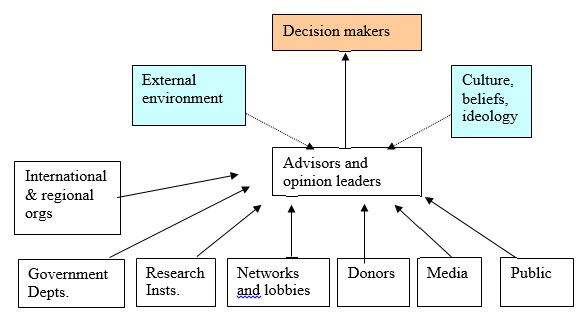
Category:
Recommended
Description and Purpose:
This tool helps to map and analyze decision-makers and their sources of influence. Influence Mapping builds naturally on Stakeholder Analysis (and, to a degree, has similarities with the drivers or influences identified in a Force Field Analysis).
Method:
Construct and influence map or pyramid.
To do this, you need to be clear about the policy issue or change being analyzed and single out those in high positions of power. Then, differentiate between the decision-makers who have the actual responsibility to make the decisions in a specific policy area, and their opinion-leaders who can influence them or lead their opinion, and who are generally more accessible.
Every policy-maker depends on a group of advisors or specialists without whom they cannot operate. They are also accountable to, a wide group of interest groups, constituencies and lobbies. Further, they may be influenced by the nature of the information and research they receive, how it is reported in the media, the political regime, not to mention their own beliefs and ideologies. It is often helpful to map the information as a pyramid of actors and influences.
You can separate actors and other (more general) influences (e.g. by color coding or different arrows).
Discuss this as it is under construction. Which actors or influences would be difficult to convince on your issue, and why? Which may be easier to approach, and could be effective influences? Bring out interesting and new angles and approaches – for example, by linking your issue with their priority concerns.
You could try brainstorming the key individuals and institutions that carry the influence (e.g. specific people, newspapers, veterinarians, animal behaviorists, farmers etc.). This allows the group to analyze possible influence channels.
Once key channels have been identified the group should analyze their position on the topic, their key motives and their accessibility. Are they a supporter, an ally or uncommitted? Sometimes they can have a different status on different issues. What are their interests and motives for a particular position on the issue? What is their agenda, either stated or implicit? What drives them to take this position, and what constraints do they face that might make it difficult for them to move from this position. This may be ideological or personal, or it could be cultural or social. It might be financial (e.g. for monetary gain) or it may be political, based on the views of their interest groups, supporters, patrons and voters, the constituents who give them their position of power. Finally assesses how easy it will be to gain access and present the evidence or case.
See below for an example:
You may also find it useful to research and complete the following information for each of the major institutions, organizations of agencies involved.
| Main institutions, organizations, or agencies | Most important decision-makers | Their beliefs on issue | Their interests and agendas | Major sources of influence | Scope for positive influence on this issue? | Resources |
Adapt the criteria to suit your own purposes, if necessary.
If you add contact details, you can then keep this as a permanent record (and update as new information is received).
It can also be used as a strategic planning or activity planning tool.



